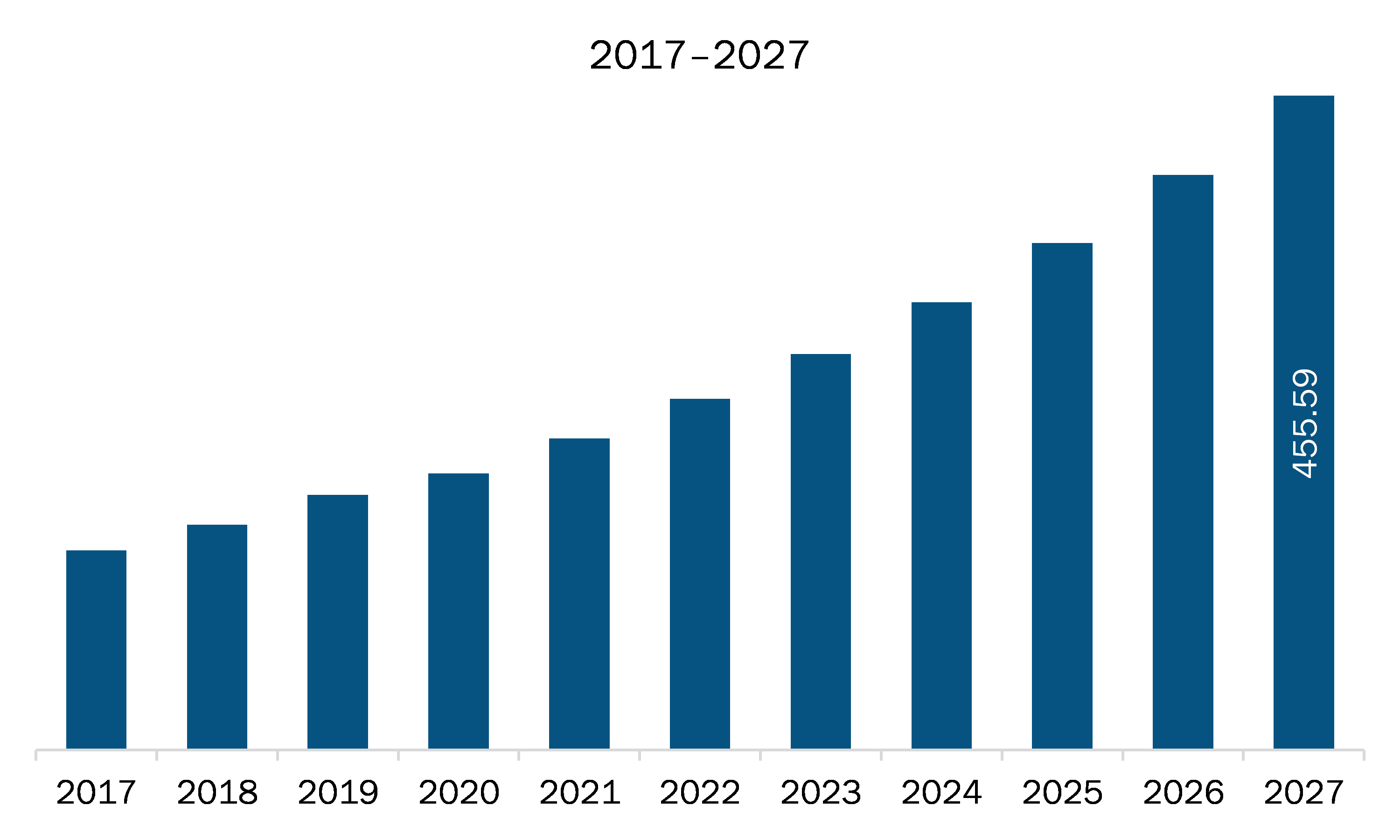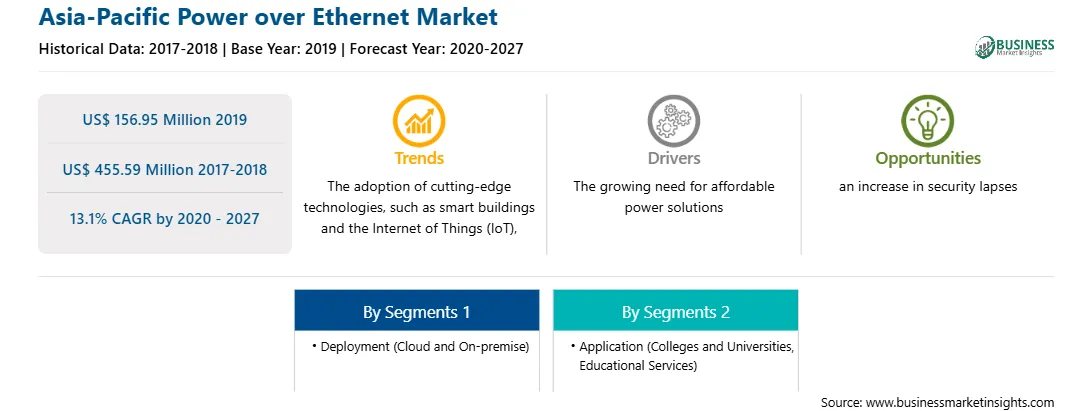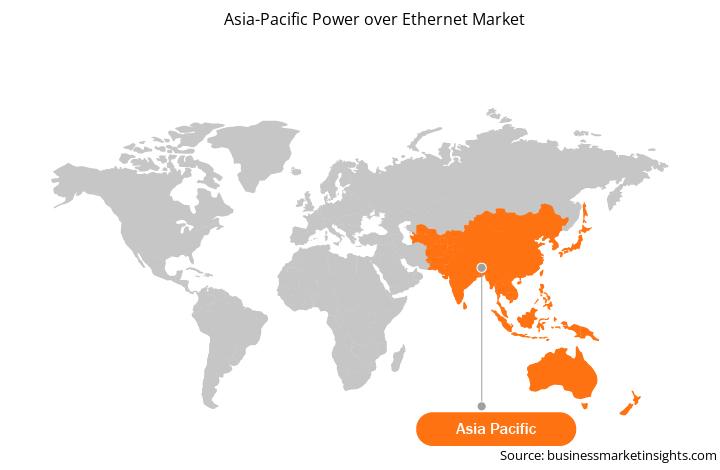The power over Ethernet market in APAC is further segmented into China, India, Japan, Australia, South Korea, and the Rest of APAC. The rise in disposable income and betterment of internet infrastructure in the Asian countries allow individuals to purchase high-end products, including smartphones, laptops, wearables, and tablets. China, India, Indonesia, and Japan are emerging markets with a large number of smartphone users. Currently, there is a high demand for cost-effective and low power-consuming consumer electronic devices with power over Ethernet connectivity. Policymakers and regulators in both developed and developing countries in APAC are creating favorable growth and investment environment for the development of industrial sector and adoption of advanced technologies such as artificial intelligence (AI), IoT, Blockchain, 5G, and monopole computing. China is contributing a considerable share to the overall power over Ethernet market in APAC. The growing telecom sector in APAC, particularly in the developing economies, coupled with increasing mobile and internet penetration, is propelling the power over Ethernet market in the region. Also, smart cities becoming significantly important is going to bolster the demand for Power over Ethernet in the coming years, which is further anticipated to drive the APAC Power over Ethernet market.
The ongoing COVID-19 outbreak has badly impacted the APAC region. The region is the manufacturing hub of semiconductors and electronics thus containment measure undertaken by the governments in this region has negatively affected the production in this region. China is the leading manufacturing country in this region and is among the worst-hit country which has ultimately impacted the production of semiconductors and electronics facilities. Further, due to the interruption in supply chain and logistics, the procurement rate of various industrial equipment has been quite affected. In India, South Korea, Japan, Vietnam, and others have witnessed a sharp decline in manufacturing activities and new projects owing the lack of availability of work force and movement restrictions. Hence, the disruptions in supply of raw materials and components and also demand from China & other Asian countries is expected to negatively impact the growth of the market in coming quarters.

Strategic insights for the Asia-Pacific Power over Ethernet provides data-driven analysis of the industry landscape, including current trends, key players, and regional nuances. These insights offer actionable recommendations, enabling readers to differentiate themselves from competitors by identifying untapped segments or developing unique value propositions. Leveraging data analytics, these insights help industry players anticipate the market shifts, whether investors, manufacturers, or other stakeholders. A future-oriented perspective is essential, helping stakeholders anticipate market shifts and position themselves for long-term success in this dynamic region. Ultimately, effective strategic insights empower readers to make informed decisions that drive profitability and achieve their business objectives within the market.

| Report Attribute | Details |
|---|---|
| Market size in 2019 | US$ 156.95 Million |
| Market Size by 2027 | US$ 455.59 Million |
| Global CAGR (2020 - 2027) | 13.1% |
| Historical Data | 2017-2018 |
| Forecast period | 2020-2027 |
| Segments Covered |
By Deployment
|
| Regions and Countries Covered | Asia-Pacific
|
| Market leaders and key company profiles |
The geographic scope of the Asia-Pacific Power over Ethernet refers to the specific areas in which a business operates and competes. Understanding local distinctions, such as diverse consumer preferences (e.g., demand for specific plug types or battery backup durations), varying economic conditions, and regulatory environments, is crucial for tailoring strategies to specific markets. Businesses can expand their reach by identifying underserved areas or adapting their offerings to meet local demands. A clear market focus allows for more effective resource allocation, targeted marketing campaigns, and better positioning against local competitors, ultimately driving growth in those targeted areas.

The Power over Ethernet market in APAC is expected to grow from US$ 156.95 million in 2019 to US$ 455.59 million by 2027; it is estimated to grow at a CAGR of 13.1% from 2020 to 2027. The application of PoE-based solutions is surging in building automation owing to its flexibility, reliability, scalability, and cost efficiency in terms of reduced cabling infrastructure and labor costs. PoE's application enables the data network to be adopted for lighting applications that are integrated with advanced sensing technologies, which range from the sensors used for people-counting to operate air quality controls. The rising requirement of intelligent building's, demands the usage of PoE in sensors, connected lighting, and other building controls. For instance, the lighting application of PoE is enabled by the digital nature of light and low-voltage DC power. The installation of PoE offers low-voltage DC power, data for the phone systems and closed-circuit television (CCTV) cameras, and potential for low-voltage devices to get installed away from AC power sources. The PoE lighting system eradicates the AC-to-DC power conversion across each lighting fixture, enhancing the overall building efficiency. Thus, increasing adoption of building automation across residential and commercial sectors is one of the significant factors for the growth of the APAC POE market.
In terms of type, the powered devices segment accounted for the largest share of the APAC Power over Ethernet market in 2019. In terms of application, lighting control segment accounted for the largest share of the APAC Power over Ethernet market in 2019. Further, commercial segment held a substantial share of the APAC Power over Ethernet market based on end user in 2019.
A few major primary and secondary sources referred to for preparing this report on the Power over Ethernet market in APAC are company websites, annual reports, financial reports, national government documents, and statistical database, among others. Major companies listed in the report are Broadcom Ltd.; Cisco Systems, Inc.; Dell Inc; Huawei Technologies Co., Ltd.; Maxim Integrated Products, Inc; Monolithic Power Systems Inc.; ON Semiconductor Corporation; Silicon Laboratories Inc.; STMicroelectronics N.V.; and Texas Instruments, Inc.
The Asia-Pacific Power over Ethernet Market is valued at US$ 156.95 Million in 2019, it is projected to reach US$ 455.59 Million by 2027.
As per our report Asia-Pacific Power over Ethernet Market, the market size is valued at US$ 156.95 Million in 2019, projecting it to reach US$ 455.59 Million by 2027. This translates to a CAGR of approximately 13.1% during the forecast period.
The Asia-Pacific Power over Ethernet Market report typically cover these key segments-
The historic period, base year, and forecast period can vary slightly depending on the specific market research report. However, for the Asia-Pacific Power over Ethernet Market report:
The Asia-Pacific Power over Ethernet Market is populated by several key players, each contributing to its growth and innovation. Some of the major players include:
The Asia-Pacific Power over Ethernet Market report is valuable for diverse stakeholders, including:
Essentially, anyone involved in or considering involvement in the Asia-Pacific Power over Ethernet Market value chain can benefit from the information contained in a comprehensive market report.